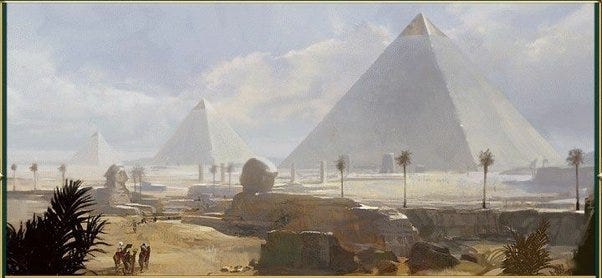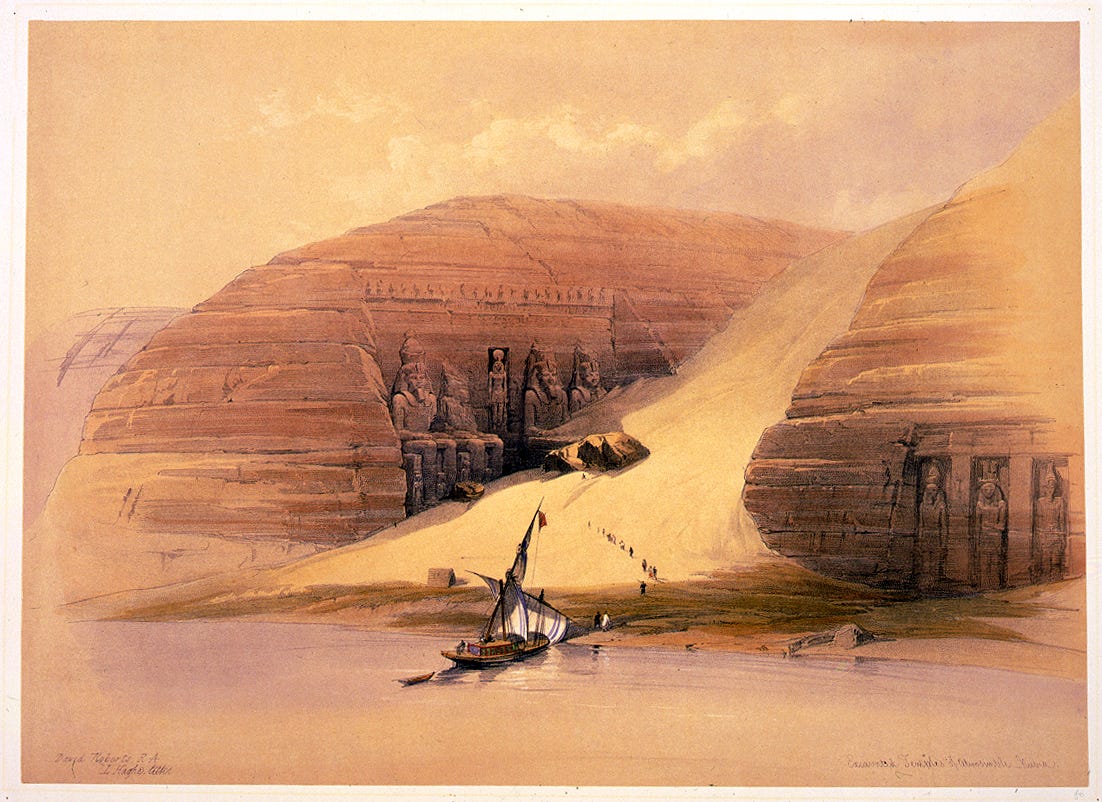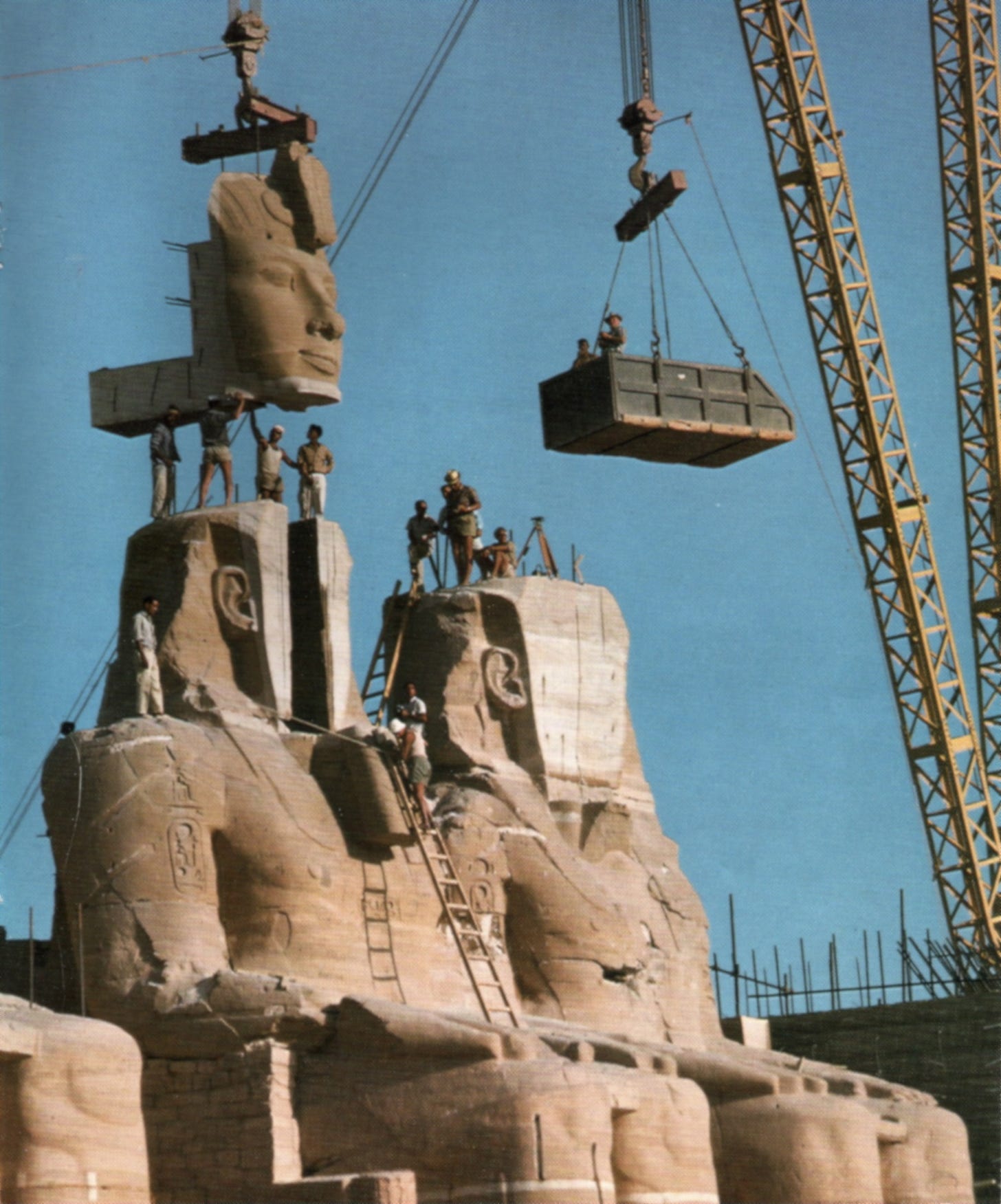Abu Simbel: Built in 13BCE, relocated 1960s, illuminated twice a year. Why?
2 days each year does this Egyptian festival get the spotlight - literally!
Turns out, I didn’t know much about the Pharaohs…
So first off, there were a lot of them - the empire lasted for over 3000 years!
Unsurprisingly, God’s merged, un-merged, were forgotten and then remembered. Looking only at their creation myth alone, there were some interesting variations:
a creator God (Atem) arose from primordial waters of chaos and spoke to create everything in existence including other gods
Later, it was said that 4 pairs of Gods rose from the water instead
Then later, a different creator god called Ptah created the world and the previous god
Then then later, all gods were replaced by just one - representing the sun
Then then later last, a different God was the creator among other gods.
Oh, and their names and personalities merge throughout all of this too!
So there are different creation myths, because there are different Egyptians - across time, location, dynasties and cultural borrowing. He is my short history:
~6000BC: agricultural based civilisations existed across Egypt and Nubia (now Sudan)
In fact there are more pyramids in Sudan than Egypt
~3100BC: King Narmer (a.k.a Menes) unified Egyptian cities into the ‘Old Kingdom’ dynasty which lasts for around 1000 years, where they centralised government and power, pushed the Ra focused religious views and built the Great Pyramid of Giza.

2181BC: the Old Kingdom collapses and city/regional rule occurs, though there is no singular cause to the collapse
2055BC: The ‘Middle Kingdom’ rose and lasted for 400 years. In this time, science grew with practicing hydraulics to water agriculture, international trade and conquest began, and the belief in Osiris as God of the afterlife started.
1650BC: the Middle Kingdom collapses again, but this time due to pressure from the Hyksos Dynasty who began taking large parts of Northern Egypt with horse drawn chariots, bronze armour and moats.

1550BC: the ‘New Kingdom’ rises, pushing the Hyksos out of Egypt and the Empire grows to its largest size through conquest - from Turkey, to Libya, to Sudan. This brings huge wealth, riches and gold. The Valley of Kings is constructed in this time, Atenism is forced on the Empire and is 300 years later removed by Tutankhamun, and Ramesses the Great builds the empire to its pinnacle - including building the Abu Simbel temple.
1070BC: the empire beings to slowly collapse once and for all for the lands to be taken by the Persians (Cyrus the Great’s son), Greeks (Alexander the Great) and Romans (Augustus Caesar).
30BC: marks the end of the last Pharaoh - Cleopatra. She was ousted by her brother as a vassal to the Greek dynasty, then also courted Julius Caesar and brought the Roman army to annex Egypt under her control. When Julius was assassinated and the power struggles of Rome started, she sided with and married Marcus Antonius (one of the three likely rules of Rome). Augustus Caesar ultimately took Rome and then the armies of Roman chased Cleopatra and Marcus Antonius, who both then committed suicide.

Abu Simbel
Abu Simbel was built to praise the Gods (the creator, the sun god and the god of death) and the Pharaoh himself (Rameses the Great), and they stand at the entrance and in the centre.

It isn’t just one temple either; temple of Nefertari (his queen’s) and a Goddess called Hathor!
Time reclaimed it until 1813, when a Swiss researcher began clearing the sand. The sketch below was drawn after two decades of sand removal when they finally got in!
In 1959, plans to damn the Nile were created. Without any intervention, the Nile would claim the temple under its waters.
Unbelievably, $40m (equivalent to $400m today) was raised to start work in 1964. Their plan initially was to build a giant transparent wall around (suggested by Arup), but quickly moved to dismantle and reassemble.
So what is the festival? In the morning of 22nd October and 22nd February each year, the inner sanctum is illuminated by the sun highlighting three of the four statues - but not the god of death.
At this time, thousands of people arrive before dawn to see the spectacle, taste the food and experience the Nile.
Food
Despite a huge number of well preserved papyrus being found in tombs - no recipe books have been found… so… I am going to lean more on modern Egypt.
Dinner!
Two modern Egyptian national dishes:
Dessert!
There aren’t any papyrus of dinners, but there is one of a dessert. Rekhmire’s Tiger Nut Cones - a special celebration food for the rich elites that impressed the God Ra!
Movies
I have only two to pick from this week:
The Mummy (1999)
A classic.
Cleopatra (1963)
The beginning of Elizabeth Taylor and Richard Burton’s affair, 22x over budget yet still turned a profit, and won 4 Oscars mainly due to the amount of set production that was required. Watch the trailer below to get an idea of the cost and scale!
In fairness, this film is more Roman focused than Egyptian, and takes Hollywood liberties, but it is cinematic history.
And a final interesting note, James Bond’s The Spy Who Loved Me partially was filmed here!











